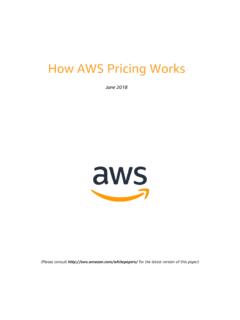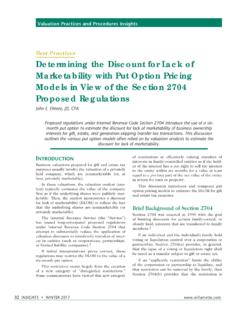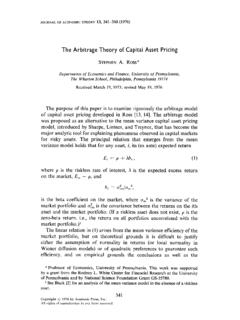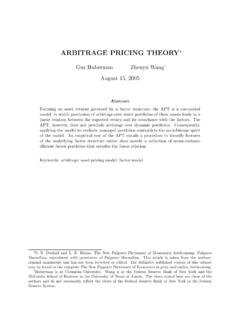Transcription of 1Factor Models - Columbia University
1 1 Factor ModelsThe Markowitz mean-variance framework requires having access to many parameters:If there arenrisky assets, with rates of returnri,i=1,2,..,n,then we must knowall thenmeans (ri),nvariances ( 2i)andn(n 1)/2covariances ( ij)for a total of2n+n(n 1)/2parameters. If for examplen=100 we would need 4750 parameters,and ifn=1000 we would need 501,500 parameters! At best we could try to estimatethese, but how? In fact, it is easy to see that trying to estimate the means, for example,to a workable level of accuracy is almost impossible using historical ( , past) data happens is that the standard deviation of our estimate is too large (forexample larger than the estimate itself), thus rendering the estimate worthless.
2 One canbring the standard deviation down only by increasing the data to go back to (say) overahundred years!Tosee this: If we want to estimate expected rate of return over a typical 1-monthperiod we could takenmonthly data pointsr(1),..,r(n)denoting the rate of returnover individual months in the past, and then average1nn j=1r(j).(1)This estimate (assuming independent and identically distributed (iid) returns over months)has a mean and standard deviation given byr, / nrespectively, whererand denote the true mean and standard deviation over1-month.
3 If, for example, a stock s yearly expected rate of return is 16%, then the monthlysuch rate isr=16/12= = Moreover, suppose that the monthly standarddeviation is = ( , a variance of ). Using (1) for our estimate withn=12yields a standard deviation for the estimate as 12= , which is larger thanthe mean! ( , confidence intervals would be worthless.) Usingn=60(5years of data),helps to lower the standard deviation for the estimate to 60= , which isalittle below half of what it was, hardly a great improvement. To get the standarddeviation down to about one-tenth of the mean would require that n= aboutn=1413 corresponding to data for 117 years!
4 As such, it would seem imperative to derive simpler Models that are not so dataintensive, and which capture enough of reality to make them Factor modelsA(linear) factor model assumes that the rate of return of an asset is given byr=a+b1f1+ +bkfk+e,(2)where thefj,j=1,..,k,arek 1random variables (rvs) calledfactors,aand thebjare constants andeis a mean zero error term rv assumed uncorrelated with thefactors,E(e)=0andE(efj)=E(e)E(fj)=0,j =1,.. factors themselves areallowed to be correlated and are meant to simplify and reduce the amount of randomnessrequired in an analysis of our assets.
5 Whenk=1wecall the model a single-factor model1 This is called thehistorical whenk 2wecall it a multi-factor model . We use the notationfj=E(fj), 2fj=var(fj), 2ej=var(ej)throughout our factors are chosen by the modeler and depend upon the type of assets beingconsidered. For example, for stocks, factors might be selected from among the stockmarket average, dividend yield of theS&P500 s Composite common stock, a measureof the risk of corporate bonds, interest rate variables, and various macroeconomic fac-tors that capture the state of the economy such as employment rate, monthly growthrate in industrial production, monthly change in inflation rate, monthly growth rate inconsumption and in disposable income.
6 (See for example Ericsson and Karlsson, (2003) Choosing factors in a multi-factor pricing model , Stockholm School of Economics, )When there arenrisky assets indexed by 1 = 1, ,n(stocks say), then there arenequations for the model , one for each asset;ri=ai+b1,if1+ +bk,ifk+ei,i=1,.., factors are the same for each asset (that is what makes them correlated), but itis assumed that the error terms are uncorrelated between assets,E(eiej)=0,i = we form a portfolio of thenassets, defined by the weights ( 1,.., n), then infact this portfolio is itself determined by a factor model , that is, the rate of returnr= ni=1 iriof the portfolio satisfies (2) witha=n i=1 iaibj=n i=1 ibj,ie=n i=1 Single-factor Models : CAPM revisitedThe simplest case is when there is only one factor being considered;ri=ai+bif+ the mean-variance parameters can be computed directly in terms of the modelparameters:ri=ai+bif 2i=b2i 2f+ 2ei ij=bibj the original Markowitz framework, where 2n+n(n 1)/2parameters must beestimated, here we need only estimate 3n+2parameters.
7 The 2nofai,bi,onef,one 2f,andnof 2ei,asignificant savings of also thatCov(ri,f)=Cov(ai+bif+ei,f)=bi 2fand so we conclude thatbiisgiven bybi=Cov(ri,f)/ 2f(3)In general, once a factor is chosen, thea(intercept) andb(slope) constants are chosenin a least-squares sense: choose them so as to minimize the expected squared distance ofplotted data points to the linea+bf:Plot many independent pairs of realizations of (r, f)and try to find the best linethrough them. From (3) however, we see that only the interceptaneeds to be chosensince the slopebis determined from the factorfand could be of CAPM as a one-factor modelTosee that even the one-factor model is not trivial we will here derive CAPM as a specialcase of such a model .
8 (Considernstocks as our risky assets.)Tothis end, we use as our one factor, the market rate of returnrM,and for convenienceexpress the linear model for each stock viari rf= i+ i(rM rf)+ei,where iand iare apriori unknown constants (effectively, we are taking as our factorf=rM rf). Taking expected value yieldsri rf= i+ i(rM rf).Wecan compute the slope ias in (3) yielding i= i,M/ 2 Mwhich indeed is the betafrom the CAPM formula. This is CAPM exactly if i=0which is what CAPM claimsyielding the intercepta=rf(the risk-free interest rate).Thus CAPM is a special case of a one-factor Markowitz mean-variance or CAPM?
9 As we pointed out earlier, estimating parameters for the Markowitz mean-variance prob-lem is not possible by using historical (past) data only. Estimates using both past andfuture prospects of the assets, however, can be carried out and thus all is not even if this is done, since they are only estimates, the optimal solution obtainedmight be unreasonably far off from the actual solution. CAPM on the other hand usesan equilibrium approach to determine the market portfolio and in the end does notneed to solve an optimization at all; it just uses the existing capitalization weights.
10 Nei-ther approach is completely satisfying: the first has estimation error while the secondassumes apriori an equilibrium situation. Finally, both of our approaches assumes a1-period time frame as opposed to a multi-period or continuous one. What should aninvestor do?There are a variety of ways to combine and modify approaches, and there are evenmulti-period approaches that have been developed (we will study some later); but weshould recognize that the CAPM and Markowitz mean-variance are very important firststeps towards a serious quantitative analysis; financial engineering owes a lot to future information might include future plans of the company, including new products to bereleaseed, etc.

















